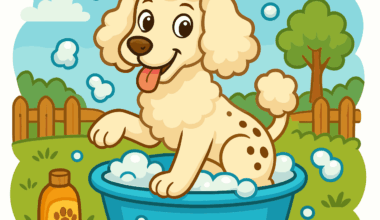The Impact of Hydration on Your Dog’s Skin and Fur
When we ponder the health of our beloved dogs, hydration is often overlooked. Yet, water plays an essential role in maintaining healthy skin and lustrous fur. Rather than just being a daily requirement, hydration influences the overall health of your dog’s coat. Dogs with proper hydration show fewer signs of dry skin, irritation, and shedding. Fur that is well-hydrated tends to be shinier and softer. Insufficient water intake can lead to various skin issues, such as dryness, flakiness, and even rashes. Moreover, dehydrated skin can impact the quality of a dog’s fur, leading to a dull appearance. Many dog owners fail to recognize the link between hydration and coat health. It’s crucial to provide a consistent source of fresh water for your dog throughout the day, especially during warmer weather or after physical activities. Regularly refreshing your dog’s water bowl can encourage drinking. Investing in a high-quality water fountain could also boost hydration levels, as many dogs prefer flowing water to stagnant sources. Consider these practical steps to ensure your dog remains hydrated and maintains healthy skin and fur.
One of the primary factors contributing to your dog’s coat and skin quality is their diet. Nutrition plays a vital role in supporting hydration levels, which directly impacts your pet’s overall appearance. Providing a balanced diet rich in essential fatty acids, vitamins, and minerals can enhance both fur and skin health. Ingredients like fish oil, flaxseed, and leafy greens help to keep the coat moisturized. Selecting well-formulated dog food that prioritizes hydration-friendly components can make a significant difference. Additionally, maintaining hydration through food can be achieved by incorporating wet dog foods or adding water to dry kibble. This method not only supplements their water intake but also increases the palatability of the meals. Regularly assessing the food ingredients is vital; some additives can lead to unnecessary dehydration. Furthermore, helping your dog limit excess shedding or skin issues relies on their nutritional needs being met. Regular visits to the veterinarian can be beneficial to customizing a diet plan. Ultimately, understanding how nutrition influences hydration will lead to a healthier coat and improved quality of life for your dog.
It’s essential to observe your dog’s hydration signs, as many pets do not drink sufficient amounts of water naturally. Dogs that show signs of dehydration may have dry mouths, sunken eyes, or lethargy. Monitoring these symptoms is crucial, as early intervention can prevent worsening conditions. Encouraging your dog to drink more water can be slightly challenging. However, there are several strategies you can utilize. Adding flavor enhancements like low-sodium chicken or beef broth can entice your dog to drink more. You might also try various dishes or bowls to see which style your dog prefers. In some cases, providing ice cubes or hydrated dog treats, such as frozen fruits, can increase interest in drinking. These methods can stimulate your dog’s interest in hydration, making it an engaging process. Moreover, exercise and warmer seasons might lead to increased water needs, so be mindful of your dog’s activity level. Regular check-ins on their water consumption can ensure they are adequately hydrated to support their skin and fur health while preventing any associated health issues.
Hydration and Skin Conditions
The correlation between hydration and skin conditions cannot be overstated when talking about your dog’s health. Dogs suffering from dehydration often present with skin issues that can be painful. Conditions like dermatitis and eczema may worsen without sufficient moisture levels in the epidermis. Continuous scratching or biting due to itchy skin leads to more injuries or infections, further complicating the scenario. Ensuring that your dog drinks adequate amounts of water can help reduce risks for such skin irritations. Regularly hydrating your dog’s skin creates a better barrier against allergens and infections. Additionally, maintaining skin hydration can lead to faster recovery from small cuts and scrapes. Using hydrating sprays or topical oils can further assist in maintaining skin moisture. It’s also important to keep your dog’s environment clean, as dirt and irritants can exacerbate skin problems. Ensure regular brushing to remove dead hair and distribute natural oils effectively. This grooming practice keeps the skin healthy while preventing matting, which can trap moisture. Overall, incorporating hydration solutions into your dog’s skin care can yield significant long-term benefits.
Aside from diet, your dog’s age and breed significantly impact hydration needs. Older dogs may show decreased thirst drives, making it crucial for owners to monitor their habits. Certain breeds are also predisposed to coat and skin issues. Breeds with thick undercoats or those prone to skin allergies require special attention to hydration levels. As dogs age, their skin elasticity can decline, and they may need more help staying hydrated. Additionally, younger dogs, as they grow, will have different hydration needs, especially during or after playtime. Understanding these differences helps in providing optimal care suited to your dog. If your dog is not drinking as much as they should, consider contacting a veterinarian. They can guide appropriate measures to increase fluid intake and examine underlying health issues. Regularly-focused hydration habits can assist in preventing potential problems. Be cautious about your dog’s environment as well, as hot weather or air conditioning can increase dehydration risks. Providing plenty of convenient water sources ensures maintained skin health across various life stages.
Encouraging Good Hydration Habits
Encouraging your dog to maintain good hydration habits can be a rewarding experience for both of you. It’s not just about dramatically changing their behavior but adopting small, daily routines. For instance, integrating water breaks into play sessions keeps your dog engaged while ensuring necessary hydration. Investing in portable water bottles during outdoor excursions means your dog always has access to fresh water. This is particularly vital during hot weather to prevent overheating. Some owners attach silicone collapsible bowls to their leashes for added convenience. Gradually, these practices can help your dog develop a routine involving regular hydration. Recognizing that your dog’s water consumption can vary based on activity and season will also guide your monitoring. For an essential guideline, aim for about one ounce of water per pound of body weight daily, but adjust based on your dog’s individual needs. Older dogs and dogs that exercise vigorously may require more fluid intake. If you utilize these simple practices, ensuring your dog stays consistently hydrated can lead to a vibrant coat and healthier skin over time.
Ultimately, maintaining proper hydration levels fosters a positive impact on your dog’s overall coat quality and skin health. By understanding the importance of hydration, pet owners can recognize its far-reaching effects on the well-being of their furry companions. Engaging in comprehensive practices surrounding hydration, nutrition, and care requires genuine effort but yields rewarding results over time. Observing hydration levels in different contexts reinforces the need for commitment to a dog’s health. The best measures involve a combination of nutritious diet plans and continuous hydration efforts. Always consider your dog’s age and breed as these factors can directly influence health and hydration needs. Consult veterinarians when in doubt, as they customize suggestions for best practices. By taking an invested approach by applying hydration methods throughout daily routines, you can enhance your dog’s skin and coat quality. The visible effects contribute to overall well-being and happiness, enriching your pet’s life significantly. Ultimately, a hydrated dog is not just a beautiful one, but a healthy, vibrant companion ready for adventures ahead.
This is another paragraph with exactly 190 words…


